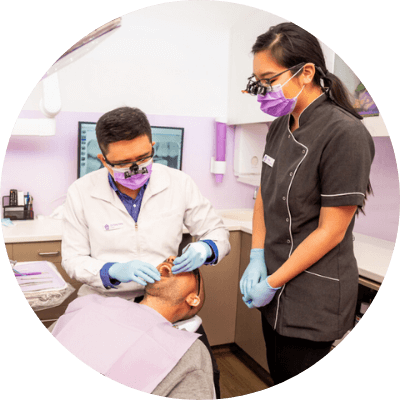Endodontics: Can Tooth Pulp Be Made Healthier?
We live at a time when we are discovering new vistas of knowledge and understanding, especially on the biological front. Endodontics: the branch of dentistry concerned with diseases and injuries of the soft tissues inside a tooth (the dental pulp) is a perfect example of this.
Dental pulp has long been a substance enclosed within a hard case, which has been largely ignored until it causes problems in the case of deep caries and subsequent infection. The pulp, however, is at the heart of the tooth and provides essential nutrients and performs an important role in its maintenance.
There are a number of immune cells in the pulp, which include macrophages, dendritic cells, and T-lymphocytes to prevent invasive microorganisms and foreign antigens. You could draw parallels with some of the revelations being made about the microbiome within the human body, in that it is an area of new discovery. The pulp tells us via pain in its neural network of the dangers of harmful stimuli within an infected or damaged tooth. The more we understand the dental pulp the better we will be able to treat teeth and their impact on human health.
New Endodontic Solutions for Healthier Pulp
There has been a move within the more progressive endodontic circles to focus more on vital pulp treatments and move away from unnecessary pulpectomies.
Root canal treatment is, perhaps, the barber surgeon approach to dentistry and not indicative of the advances made within the 21C dentistry. The alternative is proper direct pulp capping and/or pulp preservation therapies. The truth is that data tells us that the success of root canal treatment is not high. Once the infected pulp is removed the tooth becomes a non-vital entity and prone to further damage and reinfection. The development and employment of vital pulp treatments offer a less invasive and ultimately more effective endodontic solution.
“Traditional therapies such as root canal treatment are considered destructive and are often poorly carried out in general dental practice.” (Di Filippo et al, 2014; Duncan et al; 2019; Tiburcio-Machado et al, 2021)
The Real Pulp Fiction
There is a conservative minded approach to any sign of pulpitis within the dental community. A cut it out first and foremost policy exists and an ignorance about the far reaching dimensions of the nature of the pulp within teeth. Pulp vitality is for many dentists an unknown shore. Deep caries management data indicates root canal treatment is the preferred clinical pathway for most general dentists. There are, also, diagnostic issues when dentists are assessing the situation around inflamed pulp. A reliance on the patient’s anecdotally communicated symptoms does not provide a truly scientific evidential basis for assessing the correct treatment.
Direct Pulp Capping for Teeth
Pulp capping is carried out to avoid pulpitis and pulp necrosis via exposure to the oral cavity’s microorganisms. Direct pulp capping with dental materials is done to facilitate the formation of reparative dentin.
Calcium hydroxide and mineral trioxide aggregate are the two most commonly employed agents. The chemical reaction of the dental pulp with the substances causes heterogeneous dentin bridge formation to take place. There are issues relating to the setting ability of these agents and their cytotoxic effects.
Their role is to facilitate the sealing off of the pulp from the oral cavity’s soup of bacterium and other microorganisms. There are developments with other capping agents such as mineral trioxide aggregate/calcium silicates which have provided quicker setting times and improved physio-mechanical properties.
Pulpotomy vs Pulpectomy
The pulpotomy procedure is performed in the hope of avoiding a pulpectomy.
The coronal pulp is removed surgically, and the surface of the remaining pulp is treated with a capping agent to promote the formation of a dentin bridge. Novel strategies for the regeneration of the dentin-pulp complex to induce stem cells and capillaries via growth factor have been demonstrated to work effectively. Gelatin hydrogels have been developed for the release of growth factors.
“Collagen is a major macromolecular constituent of the dentin extracellular matrix with excellent biocompatibility, and it is the most extensively studied naturally occurring material for dental tissue engineering.” (Morotomi T, Washio A, Kitamura C, 2018).
This new area of research should be encouraged, and the results more widely communicated within the industry. Tooth pulp can be made healthier, and more endodontists and general dentists need to be made aware of these more holistic approaches to dental health.
Greater knowledge distributed more widely can lead to less invasive and destructive dental treatments being carried out unnecessarily. Pulp preservation via these therapies should become the new gold standard. Skilful protection of the natural pulp at the heart of the tooth is biologically sound way forward.
References
Dent. Jon, Current and future options for dental pulp therapy. Sci Rev. 2019;55(1):5-11. doi:10.1016/j.jdsr.2018.09.001)
Duncan. Henry, Present Status and Future Directions – Vital pulp treatment and pulp preservation therapies, International Endodontic Journal, doi: 10.1111/IEJ.13688
Nie E, Yu J, Jiang R, et al. Effectiveness of Direct Pulp Capping Bioactive Materials in Dentin Regeneration: A Systematic Review. Materials (Basel). 2021;14(22):6811. Published 2021 Nov 11. doi:10.3390/ma14226811
Saoud TMA, Ricucci D, Lin LM, Gaengler P. Regeneration and Repair in Endodontics-A Special Issue of the Regenerative Endodontics-A New Era in Clinical Endodontics. Dent J (Basel). 2016 Feb 27;4(1):3. doi: 10.3390/dj4010003. PMID: 29563445; PMCID: PMC5851202.
Van Nieuwenhuysen J.P., Aouar M., D’Hoore W. Retreatment or radiographic monitoring in endodontics. Int Endod J. 1994;27:75–81. [PubMed] [Google Scholar]
Note: All content and media on the Sunbury Dental House website and social media channels are created and published online for informational purposes only. It is not intended to be a substitute for professional medical advice and should not be relied on as health or personal advice.
Services Mentioned
Related Articles
Some Sweet News For Diabetes Sufferers With Gum Disease
Diabetes type 2 is a scourge for sufferers and those with it know that well. Here is some sweet news for diabetes sufferers with gum disease. A new study performed at the University of Buffalo School of Dental Medicine made some helpful findings in this regard. The...
Bruxism In Children: Is It Influenced By Screen Time And Sugar?
Children gnashing & grinding their teeth asleep in bruxism – a scene from a horror movie. Overstimulation of sensitive minds…
Let The New Year Bring New Commitment To Your Oral Care
If you can be inspired to make one new year’s resolution this year let it be for your dental health. Let the New Year bring new commitment to your oral care in 2024 and beyond. This is no mere dentist’s selfish wish but a call for an understanding about just how...
Having A Smart Mouthguard Is A Life Changing Game Changer
In early 2023, the top league of professional players in Australasia, the NRL, along with Football Australia, acknowledged before a Senate committee the link between head trauma and serious neurodegenerative disease. Representatives from the major Australian contact...













